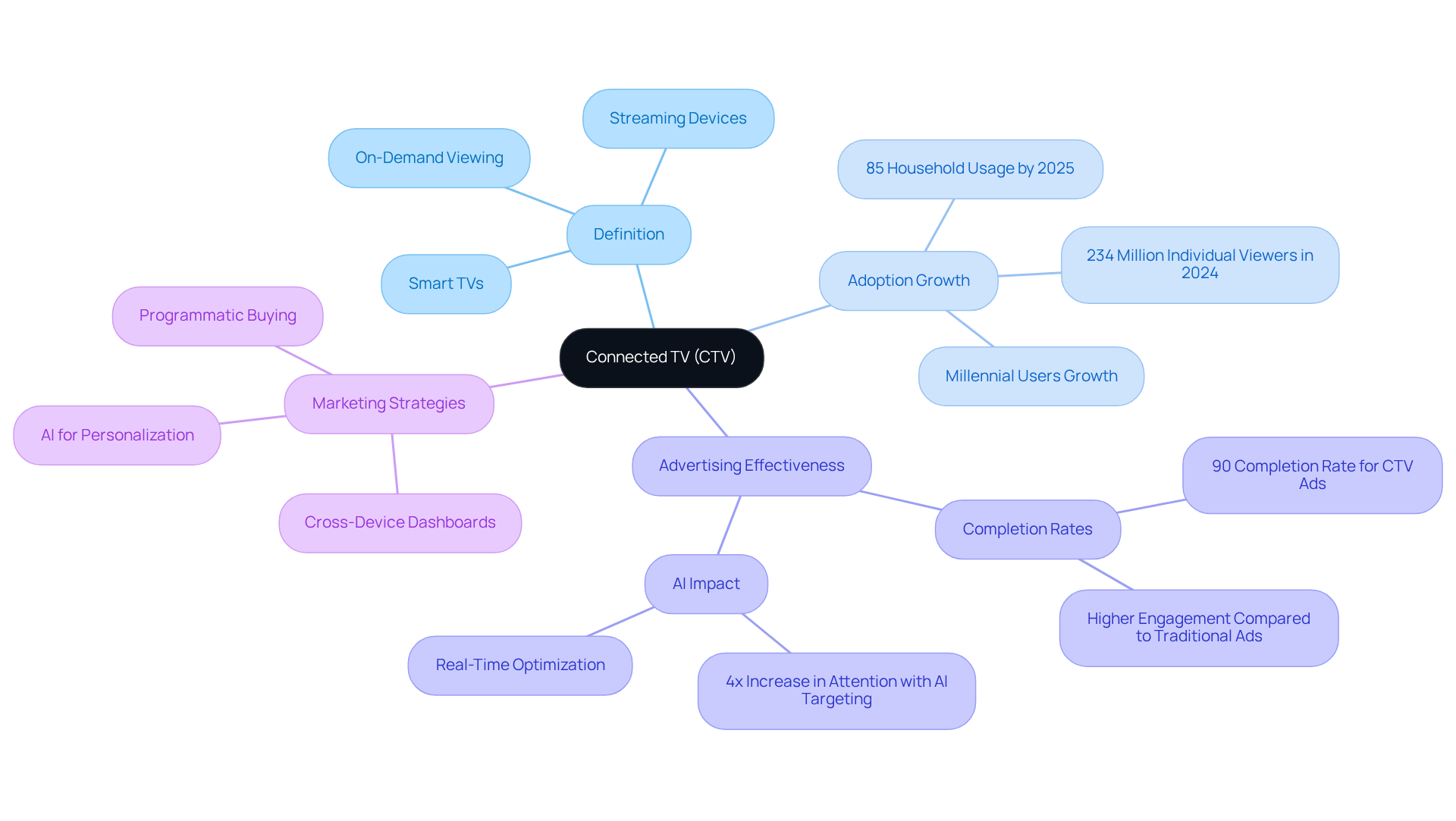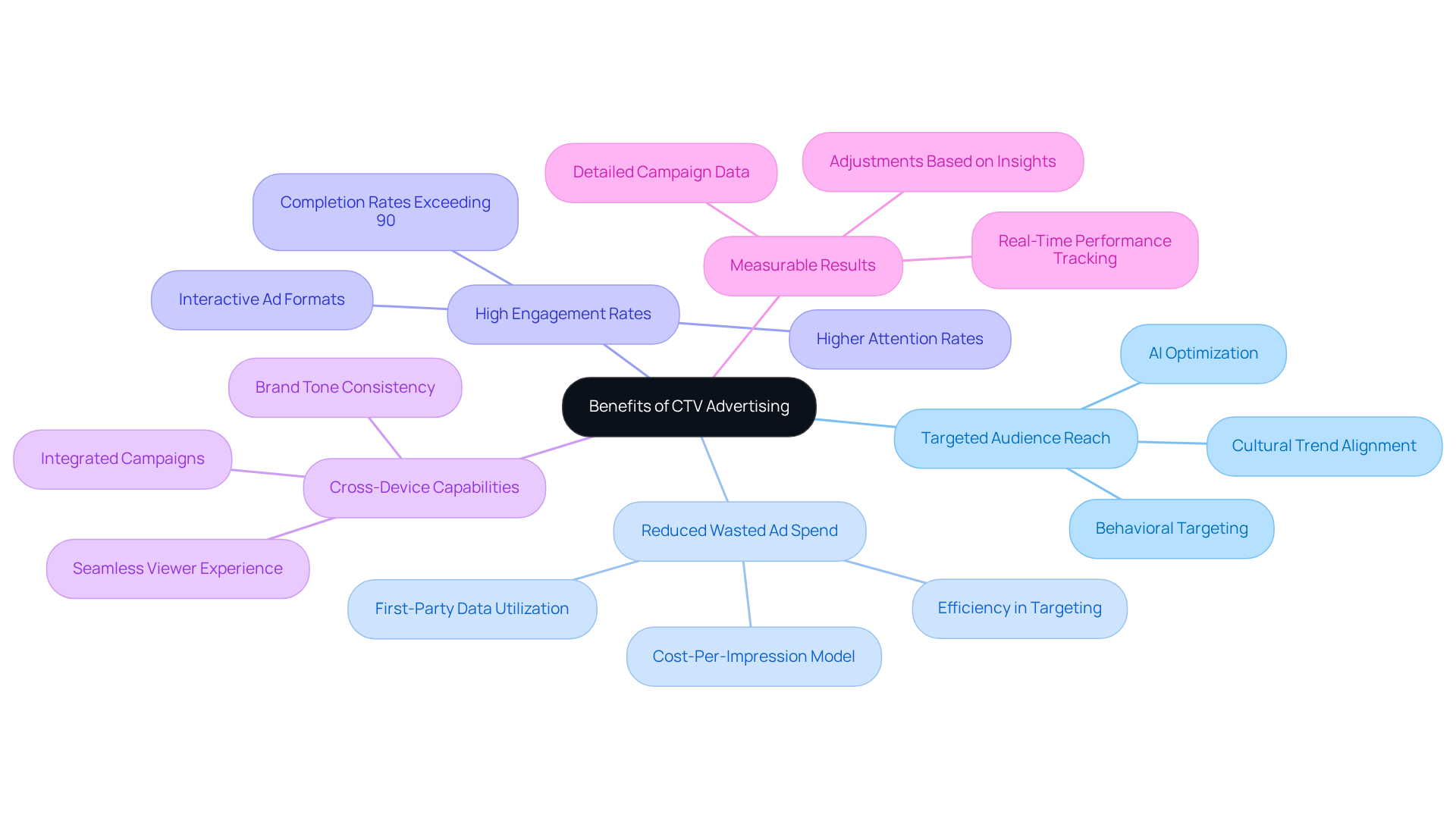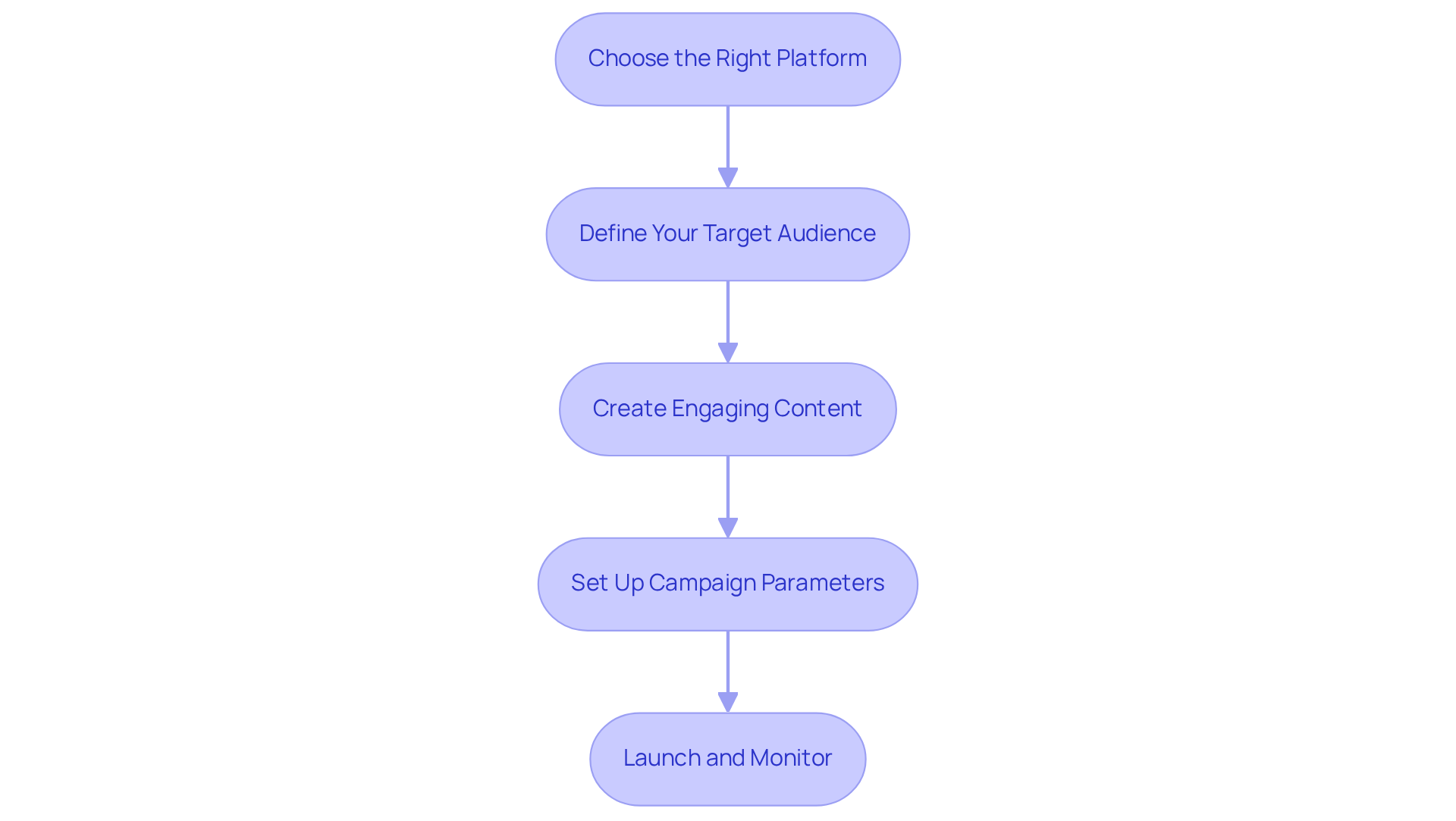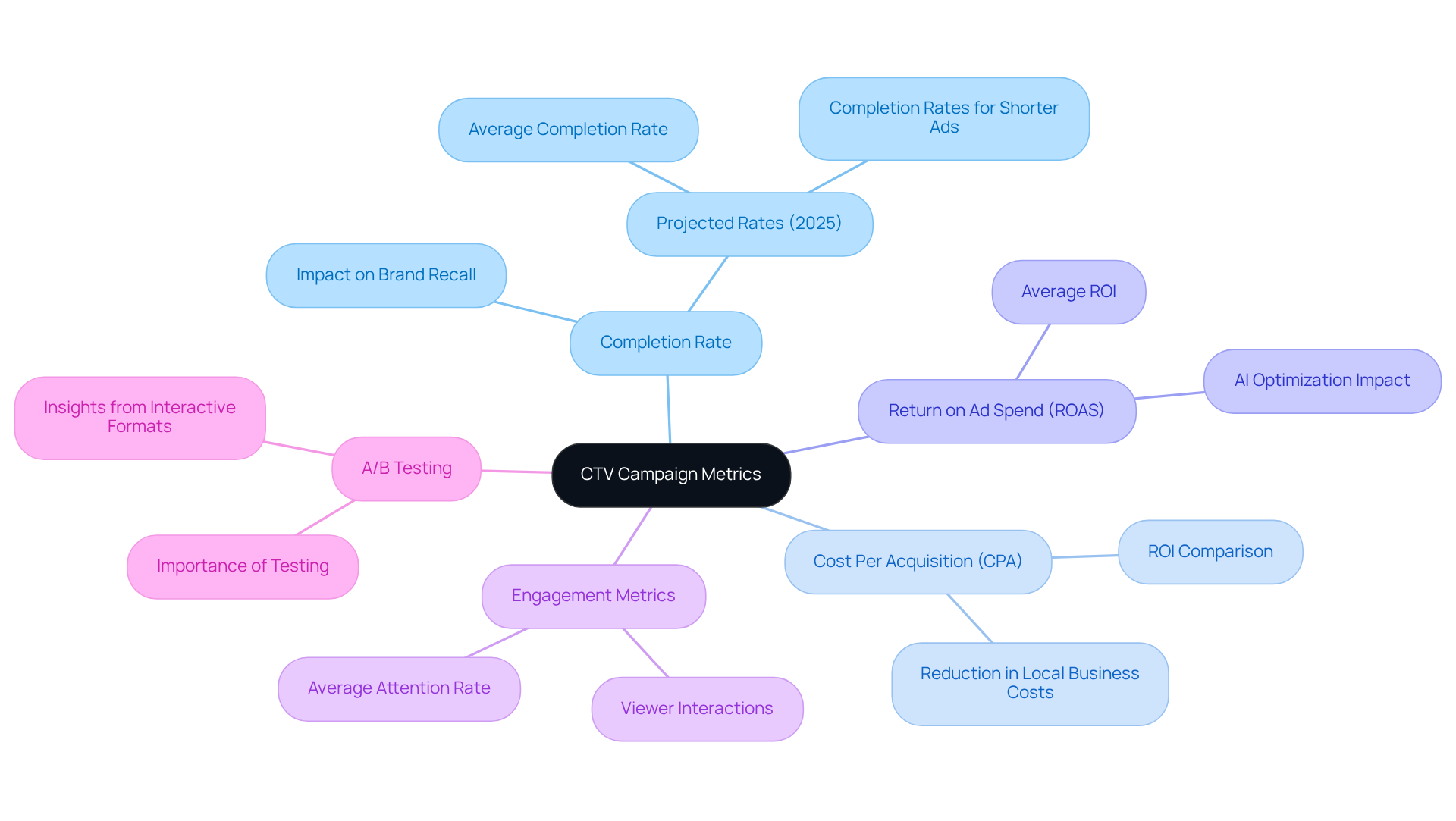Overview
The article delves into the concept of Connected TV (CTV) and highlights its substantial advantages for advertising success. It underscores CTV's unique capability to merge the extensive reach of traditional television with the precision of digital targeting.
By detailing how CTV facilitates targeted audience engagement, achieves high ad completion rates, and leverages AI for campaign optimization, the article illustrates how it enhances marketing effectiveness in today's rapidly evolving digital landscape.
This combination not only maximizes impact but also positions brands to thrive in a competitive market.
Embrace the potential of CTV to elevate your advertising strategy and drive meaningful results.
Introduction
Connected TV (CTV) is revolutionizing the way audiences consume content, merging traditional television's vast reach with the precision of digital advertising. As more households embrace CTV devices, marketers are presented with unparalleled opportunities to engage targeted demographics through hyper-personalized campaigns.
However, with this shift comes the challenge of navigating a rapidly evolving landscape.
How can brands effectively leverage CTV to maximize their advertising impact and ROI? This question is critical for marketers seeking to stay ahead in an increasingly competitive environment.
Define Connected TV: Understanding the Basics
The term CTV meaning refers to any television set that connects to the internet, allowing users to stream digital video content. This category encompasses smart TVs and devices such as Roku, Apple TV, and Chromecast. CTV empowers viewers to access a diverse range of streaming services, including Netflix, Hulu, and YouTube, signifying a significant shift from traditional cable television to a more flexible and on-demand viewing experience.
By 2025, approximately 85% of U.S. households are expected to utilize at least one CTV device, reflecting a dramatic increase in adoption over the past decade. This growth underscores the importance of CTV for marketers, as it merges the extensive reach of traditional television with the precision of digital advertising. Consequently, CTV serves as a powerful tool for targeted marketing strategies, enabling companies to effectively engage specific audience segments.
Successful CTV initiatives have demonstrated remarkable outcomes, with completion rates for advertisements exceeding 90% for 15- and 30-second spots, significantly enhancing recall and emotional connection. Moreover, AI-powered contextual targeting has been shown to increase attention to CTV ads by four times, further boosting engagement and conversion rates.
At Overskies, we leverage AI to create hyper-personalized customer experiences, optimizing campaigns through rapid generation, testing, and refinement of multiple ad versions. Our automation and custom bots replicate human speech, ensuring that companies not only reach their audience but also forge meaningful connections.
As the landscape continues to evolve, understanding the CTV meaning in marketing tactics is essential for companies striving to thrive in a competitive digital environment.

Explore the Benefits of CTV Advertising
CTV advertising presents a multitude of advantages that can significantly enhance marketing effectiveness:
-
Targeted Audience Reach: Advertisers can leverage viewer data to precisely target specific demographics, ensuring that ads reach the most relevant audiences. This capability is crucial as CTV meaning platforms enable audience-based targeting, combining the broad reach of traditional TV with the precision of digital channels. By utilizing AI, Overskies can rapidly generate, test, and optimize multiple ad versions, ensuring the most effective variant is used, which further enhances targeted reach.
-
Reduced Wasted Ad Spend: By utilizing advanced targeting techniques, companies can minimize ad spend on uninterested viewers. This efficiency is especially advantageous in a time when CTV advertising is becoming crucial for companies pursuing performance and control in their marketing strategies. AI's ability to assess vast amounts of data swiftly allows for fine-tuning campaigns, resulting in better ROI on spend every month.
-
High Engagement Rates: CTV ads boast impressive completion rates, often exceeding 90%. This high level of viewer engagement improves product recall and ensures that messages resonate with the audience. In fact, the ctv meaning indicates that CTV commands a 70% higher attention rate than mobile ads, making it a powerful medium for advertisers. The hyper-personalized interactions enabled by AI can further enhance engagement, as companies tailor their messaging to individual customer preferences, which aligns with the concept of ctv meaning.
-
Cross-Device Capabilities: CTV facilitates integrated campaigns across various devices, providing a seamless viewer experience. This cross-device functionality strengthens messaging and enables consistent engagement across platforms. AI-driven automations and custom bots can enhance this experience by mimicking human speech and maintaining brand tone across communications.
Measurable results are facilitated by the advanced analytics of CTV platforms, which help advertisers understand CTV meaning by tracking performance metrics in real-time. This ability enables prompt modifications to enhance strategies, ensuring that marketing efforts are both effective and efficient. The insights gained from AI can be instrumental in making these adjustments.
- Examples of Targeted Audience Reach: Successful campaigns, such as TheraBreath's 'Swishy Time' initiative, illustrate the power of CTV in reaching targeted audiences. By employing video retargeting and aligning with cultural trends, TheraBreath significantly boosted awareness and engagement, demonstrating the potential of CTV marketing to drive measurable results.
In summary, the strategic use of CTV promotion not only enhances audience targeting but also maximizes engagement and efficiency, making it an indispensable tool for modern marketers. Leveraging AI at Overskies further amplifies these benefits, ensuring brands can achieve optimal results.

Implement CTV Advertising: Setup and Targeting Strategies
To implement CTV advertising successfully, consider the following steps:
-
Choose the Right Platform: Select a CTV promotion platform that aligns with your objectives. Look for programmatic buying platforms that provide access to multiple streaming services, ensuring you can reach a broad audience effectively. Notably, in 2025, platforms like Adtelligent and DV360 are recognized for their robust capabilities in managing CTV inventory.
-
Define Your Target Audience: Utilize demographic, geographic, and behavioral data to create detailed audience profiles. This approach allows for the crafting of personalized ad experiences, which have been shown to significantly outperform generic messaging. As a result, you can expect higher viewer engagement and improved conversion rates.
-
Create Engaging Content: Develop high-quality video ads that resonate with your target audience. Employ storytelling methods that correspond with your brand narrative, as customized CTV initiatives have been shown to enhance brand recall and intent signals.
-
Set Up Campaign Parameters: Determine your budget, ad placements, and frequency caps to avoid ad fatigue among viewers. Balancing reach and frequency is essential for effective CTV promotion. The average frequency of CTV efforts was noted at 7.09, indicating potential for enhancement in audience engagement.
-
Launch and Monitor: Once your initiative is live, continuously track performance metrics to evaluate engagement and modify strategies as necessary. Key metrics to monitor include view-through rates and household-level attribution, which are essential for understanding the effectiveness of your CTV promotional efforts.

Measure and Optimize CTV Campaigns for Success
To effectively measure and optimize your CTV campaigns, it is essential to focus on the following key metrics:
- Completion Rate: Monitor the percentage of viewers who watch your ad to completion. In 2025, the CTV meaning indicates that CTV ads are projected to achieve completion rates averaging between 90% and 98%. This reflects the effectiveness of your content in engaging viewers.
- Cost Per Acquisition (CPA): Assess the cost associated with acquiring a customer through your CTV ads. This metric is crucial for evaluating the return on investment (ROI) of your initiatives, particularly as the CTV meaning emphasizes how promotion can lower local business acquisition expenses by 40% compared to conventional TV.
- Return on Ad Spend (ROAS): Calculate the revenue generated for each dollar spent on promotions. The CTV meaning is evident as initiatives have demonstrated a 23% greater ROI compared to conventional television, and on average, CTV advertising ROI is 4.5 times higher than linear TV. This makes this metric essential for grasping overall initiative effectiveness. Leveraging AI, Overskies can rapidly generate, test, and optimize multiple ad versions, ensuring the most effective variant is used to maximize ROAS.
- Engagement Metrics: Analyze viewer interactions, such as clicks or website visits, to gauge how well your ads resonate with the audience. High engagement rates indicate that your content is compelling and relevant, demonstrating the CTV meaning with the average ad attention rate reaching 51.5% in early 2024. AI tools can help monitor brand sentiment and reputation in real-time, providing insights that enhance engagement strategies.
- A/B Testing: Implement A/B testing with different ad creatives and targeting strategies to identify the most effective approaches. Pioneers of interactive creative formats in CTV report longer engagement and higher conversion rates, making insights gained from these tests essential for enhancing future initiatives. By employing AI to examine performance data and identify customer preferences, Overskies can refine initiatives based on essential insights and trends, resulting in focused, effective promotion.
By prioritizing these metrics and leveraging AI capabilities, marketers can optimize their CTV campaigns to ensure they resonate with the CTV meaning of viewer preferences and behaviors. Ultimately, this approach drives better results in an increasingly competitive advertising landscape.

Conclusion
Connected TV (CTV) signifies a transformative shift in the advertising landscape, merging the extensive reach of traditional television with the precision of digital marketing. As more households adopt CTV devices, understanding its implications for advertising becomes paramount for brands aiming to connect with their audiences effectively.
This article has explored the multifaceted benefits of CTV advertising, including:
- Enhanced targeting capabilities
- Reduced wasted ad spend
- High engagement rates
The integration of AI technologies further amplifies these advantages, enabling marketers to create personalized experiences and optimize campaigns in real-time. Additionally, practical strategies for implementing CTV advertising—such as selecting the right platforms and continuously measuring performance—were discussed, highlighting the importance of a data-driven approach.
In an ever-evolving digital environment, leveraging CTV advertising is not merely an option but a necessity for marketers seeking to maximize their impact. By embracing the insights and strategies outlined, brands can position themselves for success, ensuring their messages resonate with the right audiences. As the adoption of CTV continues to rise, now is the time to harness its potential and drive meaningful engagement through innovative advertising approaches.
Frequently Asked Questions
What is Connected TV (CTV)?
Connected TV (CTV) refers to any television set that connects to the internet, allowing users to stream digital video content. This includes smart TVs and devices like Roku, Apple TV, and Chromecast.
How does CTV change the viewing experience?
CTV provides a more flexible and on-demand viewing experience compared to traditional cable television, enabling viewers to access a wide range of streaming services such as Netflix, Hulu, and YouTube.
What is the expected adoption rate of CTV devices in U.S. households by 2025?
By 2025, approximately 85% of U.S. households are expected to utilize at least one CTV device, indicating a significant increase in adoption over the past decade.
Why is CTV important for marketers?
CTV merges the extensive reach of traditional television with the precision of digital advertising, making it a powerful tool for targeted marketing strategies and enabling companies to effectively engage specific audience segments.
What are the outcomes of successful CTV advertising initiatives?
Successful CTV advertising initiatives have shown completion rates exceeding 90% for 15- and 30-second spots, which enhances recall and emotional connection with viewers.
How does AI impact CTV advertising?
AI-powered contextual targeting in CTV ads can increase viewer attention by four times, boosting engagement and conversion rates.
What approach does Overskies take in CTV marketing?
Overskies uses AI to create hyper-personalized customer experiences, optimizing campaigns through the rapid generation, testing, and refinement of multiple ad versions while ensuring meaningful connections with audiences.
Why is understanding CTV important for companies?
Understanding CTV is essential for companies aiming to thrive in a competitive digital environment, as it plays a crucial role in modern marketing tactics.
.png?width=250&height=153&name=CSI-OverskiesRebrand_LOGO-01(smaller).png)

.png?width=100&height=61&name=CSI-OverskiesRebrand_LOGO-01(smaller).png)


.png?width=88&name=CSI-OverskiesRebrand_LOGO-01(smaller).png)



